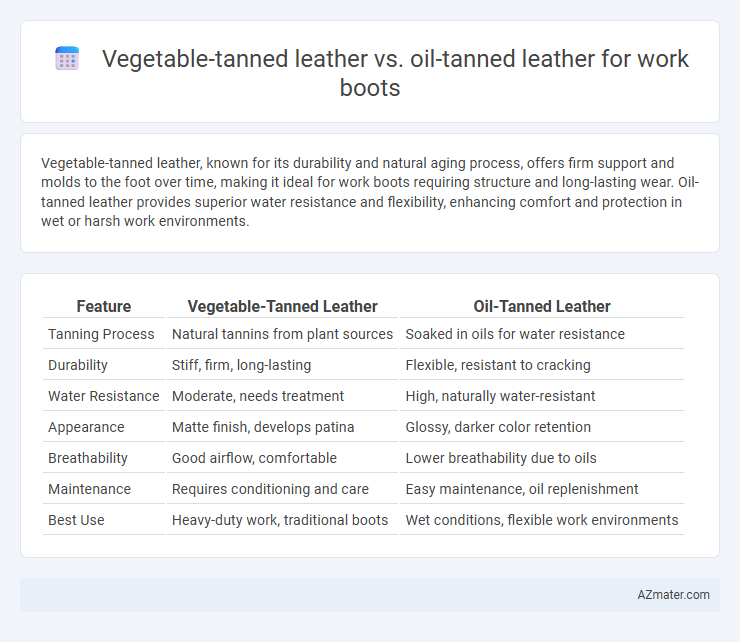Vegetable-tanned leather, known for its durability and natural aging process, offers firm support and molds to the foot over time, making it ideal for work boots requiring structure and long-lasting wear. Oil-tanned leather provides superior water resistance and flexibility, enhancing comfort and protection in wet or harsh work environments.
Table of Comparison
| Feature | Vegetable-Tanned Leather | Oil-Tanned Leather |
|---|---|---|
| Tanning Process | Natural tannins from plant sources | Soaked in oils for water resistance |
| Durability | Stiff, firm, long-lasting | Flexible, resistant to cracking |
| Water Resistance | Moderate, needs treatment | High, naturally water-resistant |
| Appearance | Matte finish, develops patina | Glossy, darker color retention |
| Breathability | Good airflow, comfortable | Lower breathability due to oils |
| Maintenance | Requires conditioning and care | Easy maintenance, oil replenishment |
| Best Use | Heavy-duty work, traditional boots | Wet conditions, flexible work environments |
Introduction to Leather Types in Work Boots
Vegetable-tanned leather in work boots offers durability and natural aging, created through tannins extracted from tree bark, which enhances breathability and molds to the foot over time. Oil-tanned leather, soaked in oils and waxes during processing, provides superior water resistance and softness, ideal for rugged environments requiring flexible yet protective footwear. Selecting between vegetable-tanned and oil-tanned leather depends on specific work conditions, balancing durability, comfort, and environmental exposure.
What is Vegetable-Tanned Leather?
Vegetable-tanned leather is crafted using natural tannins extracted from tree bark, leaves, and other plant materials, resulting in a durable and environmentally friendly leather ideal for work boots. This tanning process enhances the leather's firmness and allows it to develop a rich patina over time, providing both longevity and aesthetic appeal. Unlike oil-tanned leather, vegetable-tanned leather offers superior breathability and stiffness, making it suitable for heavy-duty use and long-lasting comfort.
What is Oil-Tanned Leather?
Oil-tanned leather is a type of leather treated with oils and waxes during the tanning process, resulting in a durable, flexible, and water-resistant material ideal for work boots. Unlike vegetable-tanned leather, oil-tanned leather has a softer texture and better ability to withstand harsh conditions and moisture exposure. Its enhanced resistance to wear and water makes it a preferred choice for heavy-duty work environments requiring longevity and comfort.
Durability Comparison: Vegetable vs. Oil-Tanned Leather
Vegetable-tanned leather offers firm structure and ages with a distinctive patina, making it durable but more prone to water absorption and stiffness over time. Oil-tanned leather provides superior water resistance and maintains softness, enhancing work boot flexibility and durability in wet or harsh environments. For intensive use, oil-tanned leather generally outperforms vegetable-tanned leather in durability due to its ability to resist cracking and wear under heavy exposure.
Water Resistance and Moisture Management
Vegetable-tanned leather offers moderate water resistance but excels in moisture management by allowing the leather to breathe, which helps prevent excessive sweating and keeps feet comfortable during long work hours. Oil-tanned leather provides superior water resistance due to its impregnated oils that create a waterproof barrier, making it ideal for wet work environments. However, oil-tanned leather may retain more moisture internally, potentially affecting breathability compared to vegetable-tanned leather.
Comfort and Break-In Periods
Vegetable-tanned leather offers a firmer feel initially, requiring a longer break-in period but eventually molding to the foot for customized comfort. Oil-tanned leather provides a softer, more pliable texture from the start, allowing for immediate comfort and a shorter break-in period. Work boots made from oil-tanned leather tend to retain moisture resistance and flexibility, enhancing comfort during extended wear.
Maintenance and Care Requirements
Vegetable-tanned leather requires regular conditioning with natural oils or waxes to prevent drying and cracking, making it essential to maintain its durability for work boots. Oil-tanned leather is more water-resistant and needs less frequent conditioning, offering better protection against moisture and making it easier to care for in harsh work environments. Proper cleaning with mild soap and avoiding prolonged exposure to excessive heat or direct sunlight enhance the longevity of both leather types.
Environmental Impact and Sustainability
Vegetable-tanned leather, produced using natural tannins from tree bark and plant extracts, offers a more environmentally sustainable option for work boots due to its biodegradability and lower chemical use compared to oil-tanned leather. Oil-tanned leather, treated with petroleum-based oils and synthetic chemicals, tends to have a higher environmental footprint, contributing to soil and water pollution during production. Choosing vegetable-tanned leather supports reduced chemical contamination and promotes ecological balance through sustainable tanning practices.
Best Applications: Matching Leather to Work Environments
Vegetable-tanned leather offers excellent durability and breathability, making it ideal for work boots used in dry, rugged outdoor environments like construction sites and farming where moisture control is less critical. Oil-tanned leather excels in water resistance and flexibility, well-suited for wet or oily conditions such as fishing, automotive work, and oil industry jobs where boots face frequent exposure to liquids. Matching the leather type to the work environment optimizes boot performance, comfort, and longevity under specific occupational demands.
Final Verdict: Which Leather is Better for Work Boots?
Vegetable-tanned leather offers superior breathability and molds to the foot over time, making it ideal for long-lasting comfort, while oil-tanned leather provides enhanced water resistance and requires less maintenance, perfect for harsh, wet work environments. Work boots crafted from vegetable-tanned leather excel in durability and develop a natural patina that improves with use, whereas oil-tanned leather boots are favored for their ruggedness and ability to withstand moisture without cracking. For most work boots, vegetable-tanned leather is better suited for those prioritizing comfort and long-term durability, while oil-tanned leather is preferable for workers needing immediate water protection and tough, low-maintenance materials.

Infographic: Vegetable-tanned leather vs Oil-tanned leather for Work boot
 azmater.com
azmater.com